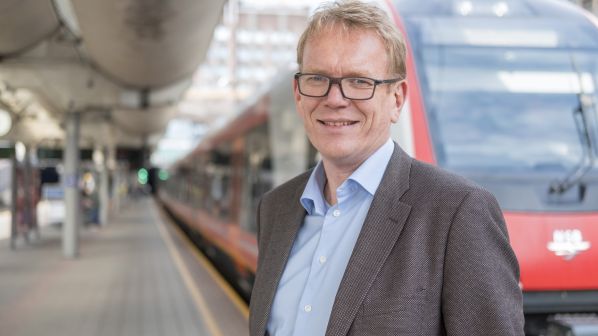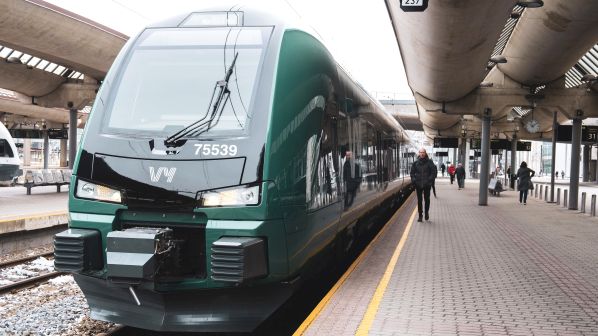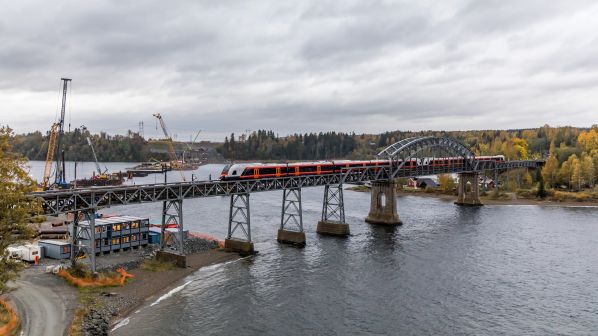LIBERALISATION of Norway’s passenger rail market in 2017 brought significant changes for Norwegian State Railways (NSB). The state-owned railway was stripped of its rolling stock and ticket divisions to focus entirely on railway operations, dramatically reducing the size and scale of the company.
With a new remit, came a new name: Vy. A Scandinavian word for outlook, the new company’s vision is to provide a single multi-modal door-to-door service. In practice, NSB has merged its rail and Nettbus bus division under the single brand. It is also embracing various new mobility solutions as well as Mobility as a Service (MaaS) as it seeks to redefine its identity in the Nordic public transport market.
The liberalisation of the rail market has meant the launch of tenders to operate packages of passenger rail services across Norway’s 4200km network. It was almost inevitable that Vy’s monopoly over domestic operation would come to an end. And it did so with the award of the first concession contract, Traffic Package 1, to Go-Ahead Nordic on October 30 2018.
The eight-year contract commenced on December 15 2019 and encompasses long-distance and regional services on the Oslo - Kristiansand - Stavanger Sørlands line, together with the branch to Arendal.
SJ Norway, a subsidiary of Swedish state-owned operator SJ, won the second contract, Track Package North, which is made up of six lines in central and northern Norway, in June 2019. It formally began operation of the eight-year contract on June 8.
“My analysis was that the winner of the first three tenders was the operator which most strongly believed in passenger growth.”
Arne Fosen, head of Vy's passenger train division
Vy subsidiary Vy Tog came a close second behind SJ in the tender with SJ putting together a stronger financial bid. Not to be deterred, Vy Tog again participated in the Traffic Package 3 West contract. And this time it came out on top, securing the nine-year concession contract ahead of TideArriva and SJ Norway in December 2019.
Traffic Package 3 West comprises passenger services on the Oslo - Voss - Myrdal - Bergen main line and is set to become active at the timetable change next month. Speaking to IRJ, the head of Vy’s passenger train division, Mr Arne Fosen, says like all of the tendered contracts, Vy is unable to dramatically alter the offer during the first year of the contract.
“You will see the trains in our new colours, but the timetable will be pretty much the same,” Fosen says. “We have made a few changes to the onboard product with a plus offering which has a better seat configuration, but it is limited so far. There is more to come.”
Fosen says it was challenging to lose the first two packages and say goodbye to colleagues. However, he says securing the third package has offered a real boost and energised the company to deliver the contract as planned.
“I think we learned and managed to improve our quality description,” Fosen says. “My analysis was that the winner of the first three tenders was the operator which most strongly believed in passenger growth.”
This is a lesson Vy was hoping to apply for the fourth package, Traffic Package 4, to operate services around Oslo. However, the Norwegian Railway Directorate announced in July that tendering would be delayed by a year due to the uncertainties caused by the coronavirus pandemic.

The package was due to be awarded in the autumn of 2021, with services beginning with the December 2022 timetable change. The directorate said at the time that the package will now be tendered in January 2021 and awarded in early 2022, with services beginning in December 2023. However, with coronavirus uncertainty persisting, there is a chance that this timetable might now be pushed back further.
“A delay will reduce the overall uncertainty for the train operators, and help us get good and fair competition for our passengers,” said Ms Kirsti Slotsvik, the head of the Railway Directorate, at the time of the announcement. “Our task is to facilitate fair competition, which will provide the best possible offer to passengers at the best cost.”
Pandemic
Vy was left to fend for itself in the early weeks of the pandemic which, as passenger numbers fell by 80%, forced the company to fully or partially lay off a significant number of its 9500 total staff. Around 900 drivers also took a pay cut.
The Norwegian government eventually stepped in to offer support on April 7, providing NKr 550m ($US 59.3m) to passenger operators to retain a virtually full timetable. The payments were backdated, and from March 12 to May 31 operators received NKr 395m.
Fosen says this enabled Vy to call people back and restart its full service, recovering to around 40-50% of its pre-pandemic passenger volumes. The government has set aside a further NKr 4.6bn to purchase passenger transport services in its 2021 budget announced last month (see panel). An additional NKr 650m is available to make up any potential shortfalls depending on the speed of the recovery.
“Norway is a green part of this planet,” Fosen says. “Luckily for us they have treated us as a priority when every corner of society is screaming for money.”
Despite the support, there are still limitations on Vy’s offer. Vy’s Oslo - Gothenburg service remained suspended as IRJ went to press but Fosen says the hope is that it would resume this month, albeit on a limited basis. SJ confirmed to IRJ that its Oslo - Stockholm service would remain suspended until at least December 12 with the chance that this could be prolonged depending on the Covid-19 situation.
Fosen says part of the reason for resuming the cross-border service is for drivers to retain their competency at a certain level on both the Norwegian and Swedish sections of the route where there are differences in the systems and rules used. He is also hopeful that as the Christmas season approaches demand will increase among leisure travellers.
This was the case on the Bergen Line where Vy waited until July to resume a full service when demand returned from tourists heading into the mountains. Capacity is though limited to 50% of previous levels in order to enforce social distancing measures. Timetabled services on the scenic Myrdal - Flam line, however, have not gone beyond 60% of their previous levels with little prospect of a full service resuming for the time being as tourism remains suppressed.
“We have followed government advice throughout the crisis, we never underdid, or overdid, the advice they gave. It is much easier to hold that line.”
Arne Fosen
“The government still wants us to work from home if we can,” Fosen says. “They still want us to avoid travelling more than we need to and they want us to stay away from trains, buses and public services. That of course makes it very difficult to run a train operation. There are some people who do not have the choice to stay at home, so we’re needed. We look forward to having everyone back again, but whether everyone comes back is one of the big issues now.”
Like other operators, Vy has sought to reassure passengers that using its trains is safe. It has employed extra cleaning measures, introduced social distancing, and followed mandates for passengers and staff to wear face masks. It also ceased selling tickets onboard trains during the early months of the pandemic. “We have followed government advice throughout the crisis,” Fosen says. “We never underdid, or overdid, the advice they gave. It is much easier to hold that line.”
Fosen adds that Vy will proceed with operational plans for Traffic Package West as planned. In the short-term though, he hopes there is some greater clarity on what is deemed an appropriate level of service to offer given continuing low levels of demand.
“I hope that the government and operators can come together and use their common sense to balance supply and demand and have discussions of whether the service is at a level that society actually wants,” he says.
If, and when, normalcy resumes, Vy’s strategy for increasing patronage on the Bergen Line for Traffic Package West is focused on attracting more domestic and overseas tourists, and to encourage more Norwegians to travel the entire route as an alternative to air travel.
The opening of a new 7.8km Ulriken double-track tunnel in Bergen next month, upgrades to the existing tunnel and a 1.8km track-doubling project between Fløen and Bergen, which will be completed in 2022, will help to increase the number of trains that can travel in and out of the city. However, capacity on the rest of the line remains restricted.
“Around 90% of the journey takes place on single track with few possibilities for trains to pass,” Fosen says. “We are aware of that and our timetable takes that into consideration. On some days we run more trains than others, so there is the possibility to run more trains more often and fill the trains with passengers. This is the starting point for our plan.”
Fleet replacement
The operator is also set to benefit from a plan announced last month by state-owned rolling stock asset owner, Norske Tog, to replace the country’s entire long-distance fleet of up to 100 trains between 2025 and 2033.
Norske Tog held an exploratory meeting with concerned and interested parties at the end of last month. Half of the existing stock will be replaced within the next five years with a single new train type, beginning with the Bergen Line fleet, which will be followed by fleets used on the Dovre, Sørlands and Nordlands lines.
The initial phase of the plan also prioritises the complete replacement of overnight stock. While Vy lost the operation of the Oslo - Trondheim and Trondheim - Bodø overnight trains, which are included in Traffic Package North, and Oslo - Stavanger, which is part of Traffic Package 1, it retains Oslo - Bergen overnight services. It has also expanded its presence in the Swedish overnight market. Vy’s Swedish subsidiary Vy Tåg won the tender to operate the Stockholm - Kiruna - Narvik overnight service in February, re-establishing itself on the route it first held from 2000 to 2003, which was its first venture into Sweden.
“We don’t have a huge expansion strategy but we will take part in the competitions when they are announced, as we have done in Sweden and in Norway,” Fosen says. “We have seen the development of interest in night services in Europe but our plan is to stay in Norway and Sweden and develop that.”
Vy Tåg also operates Sweden’s Norrtåg, X-Trafik, and Kröstågen regional concessions, and secured a nine-year contract extension for the Värmlandstrafik concession in February, which will commence next month.

next month.
Swedish expansion reflects Vy’s desire to offer a comprehensive public transport service across the Nordic region. Vy Buss is Norway’s largest bus operator with a 25% market share, operating services in Sweden through subsidiaries. It has also developed a universal public transport offer for passengers through the Vy app. Users can now search for a public transport journey between any address in Norway or Sweden.
As well as showing main line, metro, light rail and bus services and connections, the app includes the location of e-scooters and rental bikes in urban locations. Vy also recently added the capability to book a taxi from its own app. “The next step is to provide tickets for the entire journey,” Fosen says. “There are developers working on that right now.”
Vy also offers its own electric car rental service in Oslo. These cars are available to use by anyone who is registered with the designated app, and are charged based on the time they are in use.
While Vy is keen to embrace connected journeys, how public demand for these services evolves is very much dependent on how the coronavirus pandemic plays out, according to Fosen.
“We don’t have a huge expansion strategy but we will take part in the competitions when they are announced.”
Aren Fosen
With people adapting to working from home over the past eight months, he says there is now a strong possibility that not everyone will return to working in the office, 9-5, five days a week. Instead he foresees a scenario where office working is combined with at least one or two days at home, and where the morning peak is spread over a longer period, as experienced in recent months.
“None of the analyses I have seen so far expect 100% of those who travelled in January to be back when the virus has gone,” Fosen says. “They all expect fewer people to use the train, and the discussion is whether that will be 10-15-20-25% less. That is of course very challenging for any operator, especially if you are on a contract where you are dependent on ticket income.
“Will our monthly ticket, which is actually based on travelling every day, still be interesting for them? Or will they ask for other products?”
2021 will be challenging for Vy and all rail operators. There are signs that it could be the start of a new era for how operators serve their passengers. However, given the uncertainty, Fosen pleads patience in coming up with a new strategy.
“I think the last six months have shown us that you might have a fantastic discussion and conclusion in the morning, but it could be completely idiotic by the afternoon,” Fosen says. “Because things change too fast, it is difficult to say how next year will be.”
Norway set for record rail investment in 2021 budget
THE Norwegian government has allocated NKr 32.1bn ($US 3.51bn) towards investment in railway infrastructure projects, operation and renewal in 2021, an increase of 20% compared with 2020, and more than double the budget allocated in 2013.
The budget includes NKr 16.1bn for investment in new infrastructure and NKr 1.2bn for investment planning. Projects set to benefit include:
- Dovre Line track doubling: Construction work on the 13km Venjar - Eidsvoll - Langset section is continuing while work will start on the 1.8km Kleverud - Sørli section in 2021. Planning is also underway on the 14km Sørli - Åkersvika section of the Oslo - Lillehammer line.
- Vestfold Line track doubling: Construction will continue on the 10km Drammen - Kobbervikdalen and 14km Nykirke - Barkåker sections of the Oslo - Tønsberg line.
- Østfold Line: work will continue on the 22.5km Oslo - Ski Follo Line project, which is Norway’s largest transport infrastructure project and includes a new 19km tunnel and will support speeds of up to 250km/h. Work is also underway on 10km of track doubling on the existing line between Sandbukta, Moss and Såstad.
- Bergen: following the opening of the Ulriken tunnel in December, work will commence to renew the existing tunnel, which when completed will provide a double-track line between Bergen and Arna.
The budget allocation means that planning of the Ringeriks line E16 joint rail and road project between Høgkastet and Hønefoss will conclude in 2021. The budget also supports continuing electrification of infrastructure in Trøndelag, specifically the Meråker line between Hell and the Norway-Sweden border at Storlien, and Leangen - Stavne line, and the Trønder line between Trondheim and Værnes which will commence next year. The rollout of ERTMS will also continue, with ETCS set to be activated on the Nordlands and Gjøvik lines in 2022.
Bane Nor will receive NKr 9.18bn for operation and maintenance of the railway network in 2021, an increase of NKr 500m, with NKr 400m less allocated to planning.
However, the NKr 2.7bn allocated towards infrastructure renewal was criticised. The infrastructure manager says that in order to maintain the status quo, NKr 3.5bn is required annually. Under the current proposal the current maintenance backlog will increase to NKr 23bn by the end of 2021.
Bane Nor introduced a new company structure on October 1 in order to better tackle the infrastructure maintenance backlog. The company is now split into four divisions: Development, Operations and Technology, Customer and Market, and Property.
The infrastructure manager estimates that it can save NKr 500m annually by streamlining administrative activities. It has also reduced the number of train control centres from eight to four, which will later be reduced to three. In addition, the ownership of Spordrift, which Bane Nor previously assigned to execute infrastructure operation and maintenance contracts, will transfer to the Ministry of Transport from January 1 2021, and the company will compete for these contracts, potentially reducing costs.
A major reorganisation of the company, affecting 3400 employees, and combining operation of the railway into a single body is also expected to offer savings along with the benefits offered by digitisation of processes.

